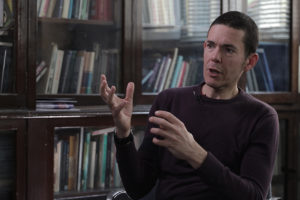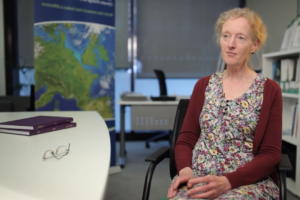A flourishing biosphere with atmospheric nitrogen ...
New Nature article debate dating of nitrogen fixation emergence

Wildfires are part of the natural ecology of boreal forests — circumpolar forests in Canada, Alaska, and Siberia. Many of the species there have learned to survive and thrive in a regime of semi-regular fire activity. Typically, a fire starts on the forest floor, but if the conditions are right, the fire can be carried up into the canopy and become a high-intensity fire, which is also called “crown fire” or stand-renewing, stand-replacing fire. Some trees’ foliage is flammable and supports crown fires with flames of 100 meters or more.
Do people wonder whether fires are good or bad? From a societal point of view, fires can be a problem because they can burn into communities, but otherwise, in a fire-dependent system, they are neither bad nor good — they are natural. It is just mother nature at work.
There are three ingredients for fires to occur. The first thing is fuel: its type and the amount of it. Fuel can include conifers, shrubs, trees, needles, mosses, etc. And there are important questions about fuel: how dry is the fuel? How is it structured vertically? Does it support a crown fire? Will it allow fires to spread across a landscape?
The second ingredient is the ignition. There are two common ones: people and lightning. Globally, over 90% of fires are started by people. In the North American boreal, it’s closer to 50-50%; in some areas, there is even more lightning than people-caused fires, especially in areas with low population density.
The third ingredient is the weather: hot, dry, and windy weather is critical for fire. You get all three; you get fire.
I believe that the weather is the most important ingredient for fire. The weather influences the other two ingredients: lightning is a function of the weather, and fuel moisture is also a function of the weather. Once the fire starts, the ignition is not needed anymore because fire self-perpetuates. As for the fuel, it is essentially static, whereas the weather is dynamic and changes quite quickly.
If the wildfire is close to a community, it has to be extinguished because it’s threatening people. But if the fire is occurring away from communities or any other values to society, fire management gets a fire weather forecast for 14 days and runs a fire growth model to decide whether they do or don’t need to put that fire out. Often times it is possible to leave the fire to burn within limits, which is healthy because it kills insects and diseases. Fire cleanses the forest and a natural cycle of life. Additionally, fires can be beneficial because a recently burned area is unlikely to reburn for 15-20 years or even longer. Recently burned areas can prevent new high-intensity fires from spreading.
There’s one other approach to fighting fires: it’s called burnout operations. Controlled burnout operations burn patches around communities so that when a wildfire starts to spread toward a community, there won’t be anything for the wildfire to burn, and that prevents the fire from spreading. In burnout operations, it’s important to make sure that the winds aren’t shifting because if the wind shifts during a burnout operation, it can become a head fire and become a serious problem.
There are two causes for ignition: lightning and people. All people-caused fires are preventable. So there should be education programs, fire bans, and even forest closures: access to forests may be restricted when fire danger is high. These are very effective ways of reducing human-caused fires.
In case of lightning-caused fire, if it starts near a community, we can be prepared to put it out while it’s still small. Once the fire gets the size of a football field or soccer pitch, and it’s hot, dry, and windy, the fire becomes almost impossible to put out. Once it’s large, we have to wait for the weather to change or for fire to move into fuel that does not support high-intensity fire if we wish to put it out. Using planes with water or fire retardant to put out such fires is a waste of money and time. In many places around the world, we are spending more and more money fighting fires and despite that, we see more and more fires.
Fires can be prevented by community planning. For example, green grass is a very effective fire break, so golf courses and soccer fields around the edge of the community can be “a green belt” that prevents fire from spreading.
Many fires caused by people are for agricultural purposes, and they are set deliberately. Arson can also play a role, sometimes even cigarettes, if the conditions are right, although it’s fairly hard to start a wildfire with a cigarette. In Canada, the number of human-caused fires has been going down recently, and it probably is because of the changes in education and policy: people are becoming aware of the dangers of fire when it’s hot, dry, and windy.
The warmer it gets, the longer the fire season is, and the longer the fire season is, the higher the likelihood of fire. Also, the warmer it gets, the more lightning occurs. Studies suggest that for every degree of warming, there is about a 12% increase in lightning. Lastly, as the temperature increases, the ability to remove moisture from vegetation increases almost exponentially. Unless there is increasing precipitation to compensate for this drying effect from warming, the fuels are going to get drier, and the drier they are, the easier it is for fires to start and to spread and become high-intensity fires. High-intensity fires are difficult and sometimes impossible to put out.
Climate change also causes our jet stream to change and weaken. The jet stream is the air moving from west to east called the westerlies. The high and low-pressure systems’ direction and strength are determined by the jet stream. The arctic areas are warming much more rapidly than equatorial areas, and the temperature difference between the equatorial and arctic areas drives the jet stream. But the difference is getting smaller and can lead to a more stagnant pattern like the slow-moving river with eddies that can lead to more blocking ridges, which are often called Omega blocks. Fire researchers have known for decades that blocking ridges is conducive to fire. With climate change, Omega blocks are becoming stronger and longer-lasting, and that contributes to fires. That’s exactly what happened in 2017 and 2018 along California to British Columbia and in 2019 in Alaska and parts of Siberia. The ridge is shunting the low-pressure systems to the north or south away from areas under the ridge so it stays dry, and if there is ignition and it’s warm, then there is everything needed for fire to start.
In addition (and this is perhaps even more important), as it warms, the permafrost thaws and it thaws even faster because of fires. As the permafrost thaws, a lot of hydrates, methane, in particular, are being released. Methane is 20-25 times more effective in contributing to the greenhouse effect compared to carbon dioxide. And more greenhouse gases contribute to global warming.
If we keep seeing more and more fires, forests are going to disappear and get replaced with grass, but this doesn’t mean there won’t be fires anymore: the three ingredients (fuel, ignition, and weather) will still be there.
The amount of time needed for a forest to recover from fire depends on the severity of the fire and the kind of forest: its age and type. In boreal system, many fires are stand-replacing fire that kills everything above ground. So after such fire follows the re-establishment of vegetation: ferns, mosses, and new seedlings come in. In terms of the likelihood of reburning, it is often 15 to 20 years before it will reburn, unless grass comes in: then, it can burn right away. If it’s a bog or wetland, it can take 50 or 60 years for it to recover to the point where it’s ready to burn again.
There are ongoing climate change and fire occurrence prediction research underway. Research into models that can predict how many lightning fires to expect and where to expect them, how many human-caused fires to anticipate, and when and where to expect them.
Another focus of research is on protecting communities: finding ways of planning the community and manipulating the fuels around the community. There is also social research going on: the impacts of evacuation. There are many remote northern communities and some of which can only be reached by plane. So the research focuses on finding out when is the best time to evacuate people and whether there are options to not evacuate.
Machine learning is becoming very popular in fire research. We’re doing a lot of work on artificial intelligence, and we’re using it to predict when and where to expect severe fire weather. We hope to use that to look at it in tandem with where fires will occur so that we can put resources in the appropriate spot to put out unwanted fires.
Around 400-450 million hectares, which is the size of India, burn every year around the world. Every year there are fires in the Amazon, parts of Africa, and Australia, particularly in northern Australia. The reason for some fires is the burning of agricultural fields, so it happens every year, whereas, in northern latitudes, fires occur every 50-100 years or every 200 years, depending on how dry or wet the conditions are. But these days, we are starting to see fire in places that traditionally haven’t seen fire, for example, Hawaii. The reason for this is invasive grasses which are very flammable.
In Canada, the area burned has doubled since the 60s and 70s. My colleagues and I attribute this to human-caused climate change. The Western United States has seen a quadrupling of area burned in the last 40 years. We expect to see even more fires in the future: at least another doubling of the area burned by the end of the century. Some researchers suggest a quadrupling, or even 8 or 10 times more fire, but in that case, the forest will disappear as it would be too much fire. If cultural practices or policy changes with respect to agricultural burning, some areas may see a decrease in fire activity, for example, in Africa and, hopefully, in the Amazon, but it depends on people.
Wildfires are part of our natural environment, so we know for sure that fires are not going to disappear, as there always will be those three ingredients. Our goal now is to educate people about the ways to prevent fires and to create guidelines and principles for homeowners and communities to better protect themselves against fires. The bottom line is that we have to learn to live with fire.

New Nature article debate dating of nitrogen fixation emergence

Geographer Mathias Disney on carbonate deposits in the ocean, how wildfires release the carbon in the atmosphe...

Physicist Joanna D. Haigh on how climate modelling can help in weather forecasting, the role of fundamental ph...